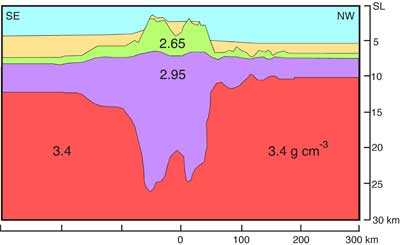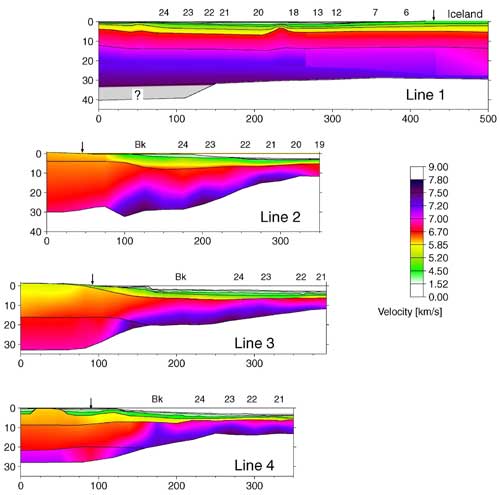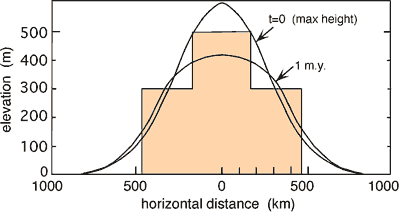The
case for mantle
plumes |
 |
Ian
H. Campbell
Research School of Earth Sciences,
The Australian National University, Canberra ACT 0200,
Australia, Ian.Campbell@anu.edu.au
Geology is principally a descriptive science. We
make observations and propose hypotheses to explain
what we see. It is rare for geologists to present
a predictive theory that can be tested by making observations
that were not documented at the time the theory was
proposed.
The plume hypothesis
was initially proposed by Wilson (1963) and Morgan (1971;
1972) to explain the age-progressive chains of volcanic
islands that stretch across the ocean basins. Wilson (1963)
reasoned that these volcanic chains were produced by
plates moving over stationary “hotspots” in
the mantle. Morgan realized that if Wilson’s
explanation was correct “hotspots” must
comprise mantle plumes originating from deep in the
mantle, probably the core-mantle boundary. Since
then improvements in our understanding of low-Reynolds-number
plumes, initially from laboratory experiments but later
confirmed by numerical models, have turned the Wilson-Morgan
explanation of oceanic volcano chains into a quantitative
predictive theory. Many of
the predictions, such as the size of a plume head and
the nature of the associated uplift, are unambiguous
and exacting. Plume
theory stands or falls on the accuracy of its predictions.
So what are these predictions, that
a skeptic can sink his or her teeth into? They are
as follows:
-
New plumes consist of a large head followed
by a narrower tail;
-
Plume heads should flatten to form a disk
2000 to 2500 km in diameter at the top of their
ascent;
-
Plume tails should have a diameter
of 100 to 200 km in the upper mantle;
-
Plumes must originate from a hot boundary
layer, probably the core-mantle boundary;
-
Plume heads should remain hot
for at least 300 Myr and be seismically detectable
for ca. 100 Myr;
-
Flood volcanism should be preceded
by domal uplift of ca. 1000 m in amplitude at the
centre of the dome;
-
Both heads and tails should
produce high-temperature magmas;
-
The temperature excess of the
plume head is predicted to be appreciably hotter
(by ca. x 3) at the centre of the head than
at the margin; and
-
Picritic magmas should be produced early during
melting of a plume head, be most abundant near
the centre of the head and less abundant towards
the margin.
The most obvious of these predictions
is that plumes must be hotter than the adjacent mantle.
This issue remains controversial. Attempts to resolve
the matter by extrapolating observed olivine-melt
compositions to primary mantle melt extraction temperatures
have proved inconclusive. Falloon
et al. (2007) and Putirka
et al. (2007) use
the same data from Hawaii and MORBs, and the same
basic approach, to come to very different conclusions
(see Chemical Geology 2007 Special Volume on Mantle
Plumes). Putirka
et al. (2007) suggest that Hawaii is 268°C
hotter and MORB whereas Falloon
et al. (2007) find
no temperature difference. The problem may
be that the extrapolation exceeds the constraints
and that the approach cannot yield unambiguous results.
A more direct approach of obtaining plume temperatures
is from the thickness of oceanic crust produced when
a spreading centre overlies a plume, using the method
of McKenzie & Bickle (1988) to calculate
the temperature of the underlying mantle. Normal
oceanic crust is 7 ± 1 km thick. The
thickness of the oceanic crust beneath Iceland is
40 km and 25 km below the Walvis Ridge (Figure 1),
requiring the temperature of the mantle under these
ridges to be 250°C and 200°C respectively
hotter than MORB mantle.

Figure 1. Seismic cross-section
through the Walvis Ridge with the interpreted densities
of the layers from Goslin & Sibuet (1975). The
basaltic root below the Walvis Ridge is up to
25 km thick and ~150 km wide The former requires the
mantle that produced the ridge was 200°C hotter
than the mantle that produces normal oceanic crust.
The latter dimension provides an upper bound for the
width of the Walvis plume. Vertical exaggeration
X 12.
The most exacting predictions of the
plume theory are that plume heads flatten to form disks
2000-2500 km in diameter when they reach the top of
their ascent, and that the shape of the uplift produced
by these flattened disks of hot mantle is domal. The
size of the flattened plume head can be obtained from
the thickness of the ocean crust along the east coast
of Greenland produced when the North Atlantic opened
close to the centre of the underlying Iceland plume
head. The length for thickened oceanic crust is 2400
km, showing that the underlying zone of hot mantle
is 2400 km wide and ends abruptly, as predicted. Equally
importantly, the oceanic crust is 17 km thick near
its margins and thickens to 33 km at the centre (Figure
2) implying that the temperature excess of the underlying
mantle is 120°C near the margin of the zone of
thickening, and increases to 260°C near the centre,
again as predicted by the plume theory.

Figure 2. Variation in seismic
P-wave
in velocity (km/s) along four traverses at the western
margin of the North Atlantic. Arrows
show the coastline and Bk the oldest oceanic crust.
The numbers along the top are magnetic anomalies.
The thickness of the first oceanic crust to form
is 33 km and 30 km for Lines 1 and 2 respectively,
near the plume axis, and 18 km and 17 km for Lines
3 and 4 respectively, near the plume margin. From
Holbrook et al. (2001).
A firm prediction of the plume hypothesis
is that the main phase of flood volcanism should be
preceded by uplift. The magnitude of
the uplift depends on the temperature excess of the
plume but is expected to be about 1000 m. Uplift
is predicted to be greatest within 200 km of the centre
of the dome but significant out to a distance of 500
km. Uplift
above the margin of the plume head is expected to be
only a few meters. There are numerous examples
of uplift preceding flood volcanism but the best documented
example is the Emeishan flood basalt in China where
the unconformity in the underlying limestone allows
the shape of the domal uplift to be recorded with remarkable
precision. The agreement between the shape of
the observed dome and that predicted by Griffiths
& Campbell (1991) and Farnetani
& Richards (1994)
is so good (Figure 3) that no reasonable person could
doubt that the Emeishan flood basalt was produce by
a mantle plume and that it originated at the core-mantle
boundary. Other observations which are consistent
with the predictions of the plume hypothesis are discussed
by Campbell (2006; 2007).

Figure 3. Uplift above
a plume head, as predicted by Griffiths & Campbell
(1991), compared with the uplift observed at the centre
of the Emeishan flood basalt (shown in beige) by He
et al. (2003). The
uplift is the minimum average value for the inner and
intermediate zones as determined from the depth of
erosion of the underlying carbonate rocks.
Many apparent disagreements of observation
with theory are readily explained by considering the
physics of mantle plumes. For
example, it has been suggested that surface heat flow
at Hawaii should be anomalously high if Hawaii sits
atop a plume. However,
the time taken to conduct heat from the top of the
plume, where its ascent is stopped by the base of the
lithosphere at ca. 80 km, is 100 Myr. Seismic
evidence suggests that there is a thermal anomaly below
the Ontong Java Plateau, which cannot be due to a plume
head, because it would have cooled in 120 Myr. However,
the thermal anomaly below the Ontong Java plateau is
predicted to be about 175 ± 25 km thick and
to take over 300 Myr to cool. Some “plumes” imaged
by seismologists branch like a cactus and thus, whatever
it is that seismologists are imaging, it is not a mantle
plume. Laboratory experiments and numerical models
both show that if one plume approaches another too
closely, they merge from the base upward to develop
a “Y” or
cactus-like shape.
However,
there are other observations that have challenged
the plume theory, four of which I now discuss.
First, the ocean floors are littered with short chains
of islands that have no associated flood basalt
or oceanic plateau and therefore cannot be due
to mantle plumes, which should start with a plume
head. Until recently, this was a valid
criticism. However, recent experiments on thermochemical
plumes (Farnetani & Samuel, 2005) show
that plume heads can stall at the boundary between
the upper and the lower mantle,
so that only part of the head ascends into the upper
mantle. The part that ascends is effectively a new
plume, and because it rises only a short distance,
it has head that is only slightly larger than the tail
and is therefore difficult to detect.
Second, there is no uplift
prior to volcanism associated with the Siberian
Traps. The Siberian
Traps, however, lie on an unconformity requiring
some uplift prior to volcanism but the predicted
domal uplift at the centre of the flood basalt has
not been documented. This might be because
it is overlain by sediments in western Siberia (Saunders
et al.,
2007).
Third,
the predicted uplift has not been documented at
the Ontong Java plateau. This
is a difficult one. Uplift can be documented
for continental basalts where the arriving plume
head raises the continental crust above sea level,
which leads erosion and an unconformity. However,
the uplift associated with a mantle plume will not
raise the floor of an ocean basin above sea level,
so no erosion prior to volcanism is expected. Furthermore,
the surface onto which the Ontong Java plateau basalts
erupted is covered by 30 km of basalt and cannot be
observed. Nevertheless part of the top of the volcanic
rocks that make up the plateau should have
protruded above sea level at the time of eruption if
the volcanism had been produced by a mantle plume,
as is the case for Iceland and Hawaii today. It is
claimed that there is no evidence of erosion on the
Ontong Java plateau. However, volcanic ash of Ontong
Java origin has been documented in ODP sites 167 and
463 to the north-east of the plateau, which requires
subaerial volcanic activity to have occurred.
Finally,
the size of the Karoo, which appears to extend from
southern Africa, through Antarctica to Tasmania (the
Tasmanian Dolerites), appears to be too big to be
produced by a single plume head. Are
two plume heads involved or was this suite of volcanic
rocks produced by some unrecognized volcanic process?
In all other respects the Karoo, as seen in southern
Africa, is a typical flood basalt.
Criticisms of a hypothesis
such as these are valuable as they encourage focus
on aspects that are not fully understood. They are
constructive and move the subject forward.
References
-
-
-
-
-
Goslin, L., and Sibuet, J. C., 1975, Geophysical
study of the eastermost Walvis Ridge, South Atlantic:
Deep structure. J. Geophy. Res., 86 1713-1724.
-
Griffiths, R.W., and Campbell, I.H., 1991, On the
dynamics of long-lived plume conduits in the convecting
mantle, Earth Planet. Sci. Lett., 103,
214-227.
-
He, B., Xu, Y.G., Ching, S.L., Xiao, L., and Wang,
Y., 2003, Sedimentary evidence for rapid crustal
doming prior to the eruption of the Emeishan floods
basalts,
Earth Planet. Sci. Lett., 213,
391-405.
-
Holbrook, W.S., Larsen, H.C., Korenaga, J., Dahl-Jensen,
T., Reid, I.D., Kelemen, P.B., Hopper, J.R., Kent,
G.M., Lizarralde, D., Bernstein, S., and Detrick,
R.S., 2001, Mantle thermal structure and active upwelling
during continental breakup in the north Atlantic,
Earth Planet. Sci. Lett., 190,
251-266.
-
McKenzie, D., and Bickle, J., 1988, The volume
and composition of melt generated by extension of
the lithosphere: J. Pet., 29,
625-679.
-
-
Morgan, W.J., 1972, Plate motions and deep mantle
convection, Geol. Soc. Am. Bull., 132,
7-22.
-
-
-
Wilson, J.T., 1963, A possible origin of the Hawaiian
Islands, Canadian Journal of Physics, 41,
863-870.
last updated 29th
May, 2007 |
